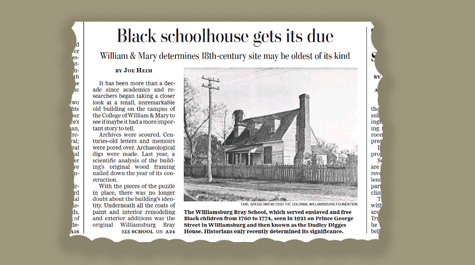After decades of research, W&M faculty earn national spotlight for Bray School discovery
Prince George House is perhaps the most inconspicuous building on a picturesque campus, but for a week or so the structure tucked away near William & Mary’s Sorority Court basked in the glow of national media.
William & Mary and the Colonial Williamsburg Foundation jointly announced in a Feb. 25 press release that the building at 524 Prince George St. contains the original structure of the Bray School, where free and enslaved Black children were educated from 1760 to 1765.
The identification of the structure that’s likely the nation’s oldest standing building used for the education of Black children was the culmination of a decades-long labor of love by Terry Meyers, Chancellor Professor of English Emeritus.
The compelling story of a historic building’s emergence from obscurity was announced at an event featuring remarks by Virginia Gov. Ralph Northam. The story was spread by a multidisciplinary team of communications professionals representing William & Mary and Colonial Williamsburg. The result was an international media coup, starting with a front page story in The Washington Post.
Then The New York Times had a story the next day. Coverage began to blossom, as multiple Associated Press outlets around the nation ran the story. Smithsonian Magazine took notice, as did local media, print and electronic.
Meyers was in high demand for interviews, as were other William & Mary scholars who have conducted scholarship on the Bray School, its students and the adults that enrolled them. W&M media sources included Jody Allen, the Robert Francis Engs Director of the university’s Lemon Project, was highlighted, as was Julie Richter, the director of W&M’s National Institute of American History & Democracy.
The press also interviewed Colonial Williamsburg researchers Matthew Webster and Ron Hurst, whose examination of the building connected the final dots of identification. Nicole Brown, a graduate student in William & Mary’s American Studies Program, was a popular subject. Her research topic is the Bray Schools of the New World, and she also works as a costumed interpreter of Bray School teacher Ann Wager for Colonial Williamsburg.
Media interest continues, as do plans for the research of the building’s structure, followed by its relocation to a site on the Colonial Williamsburg campus.
















